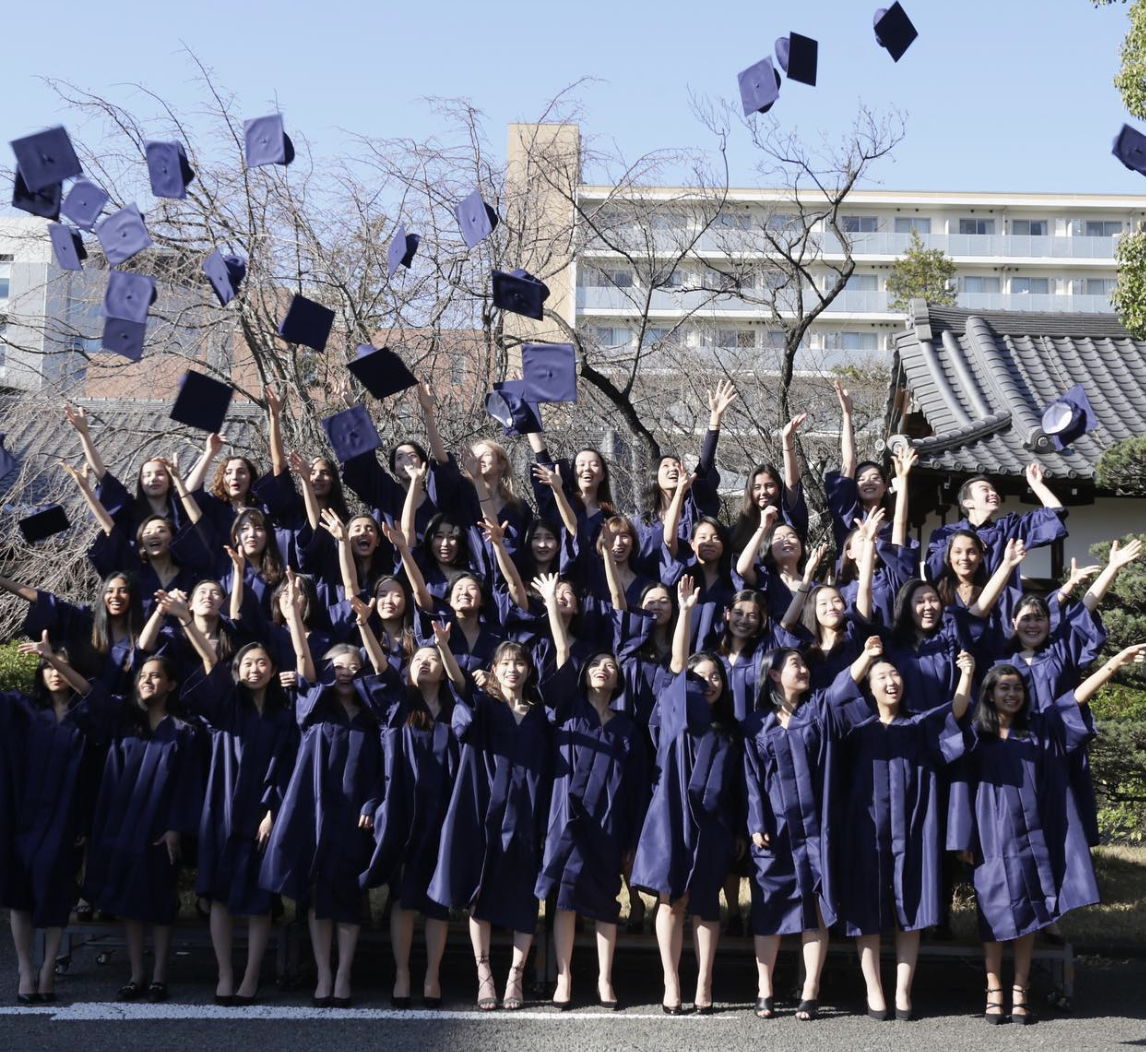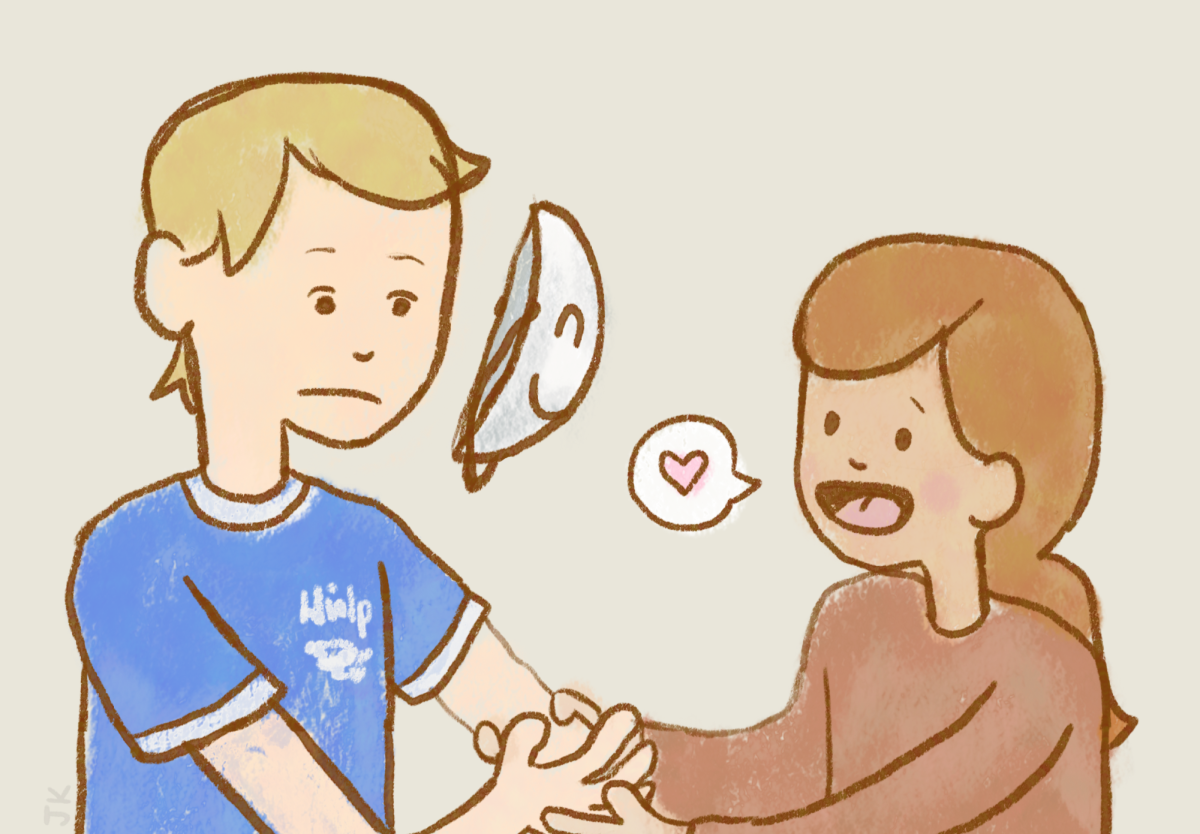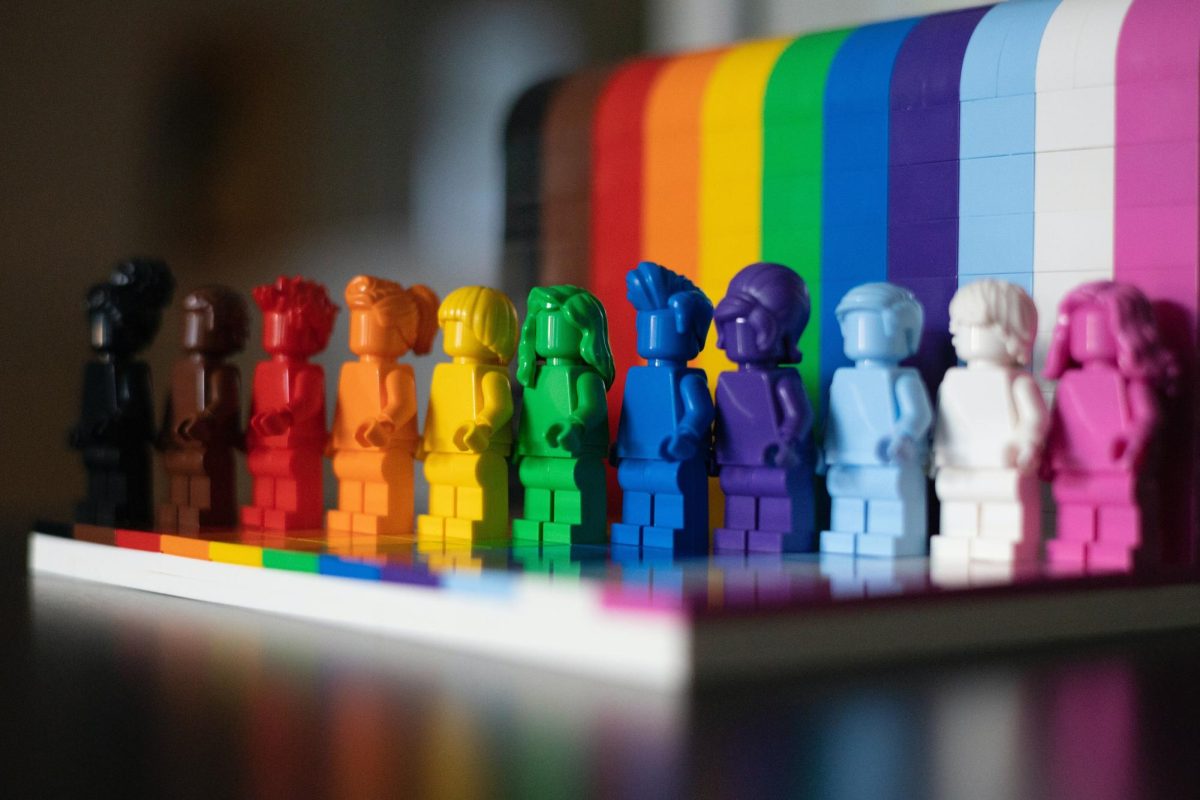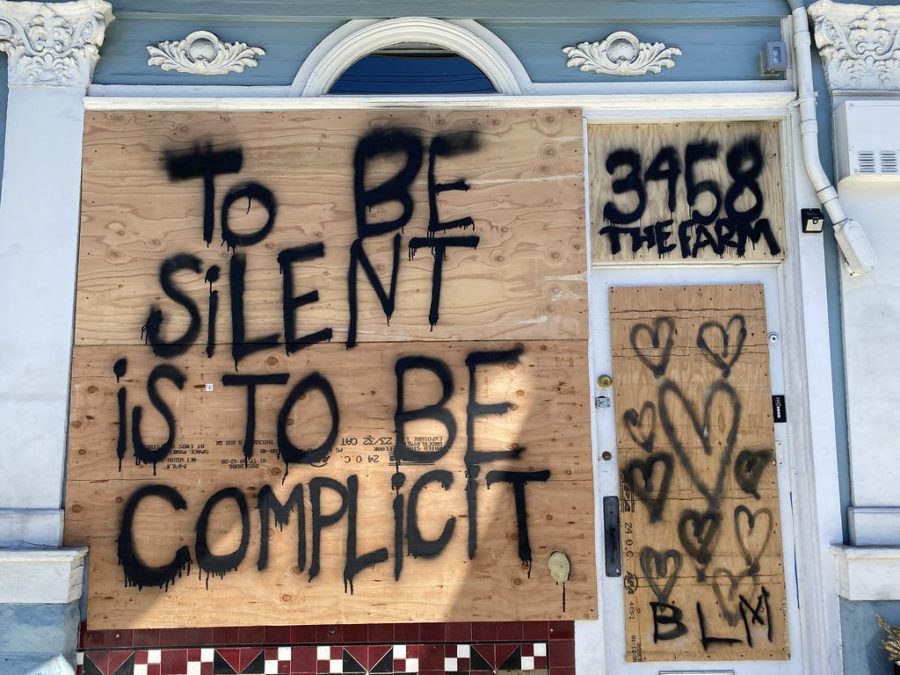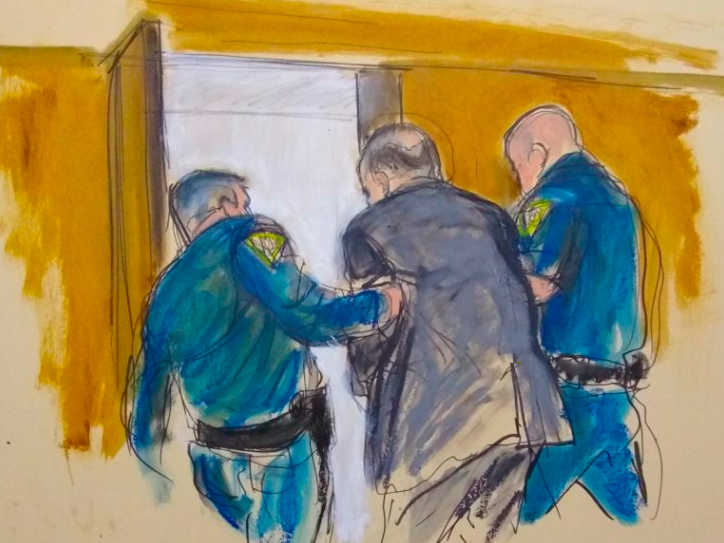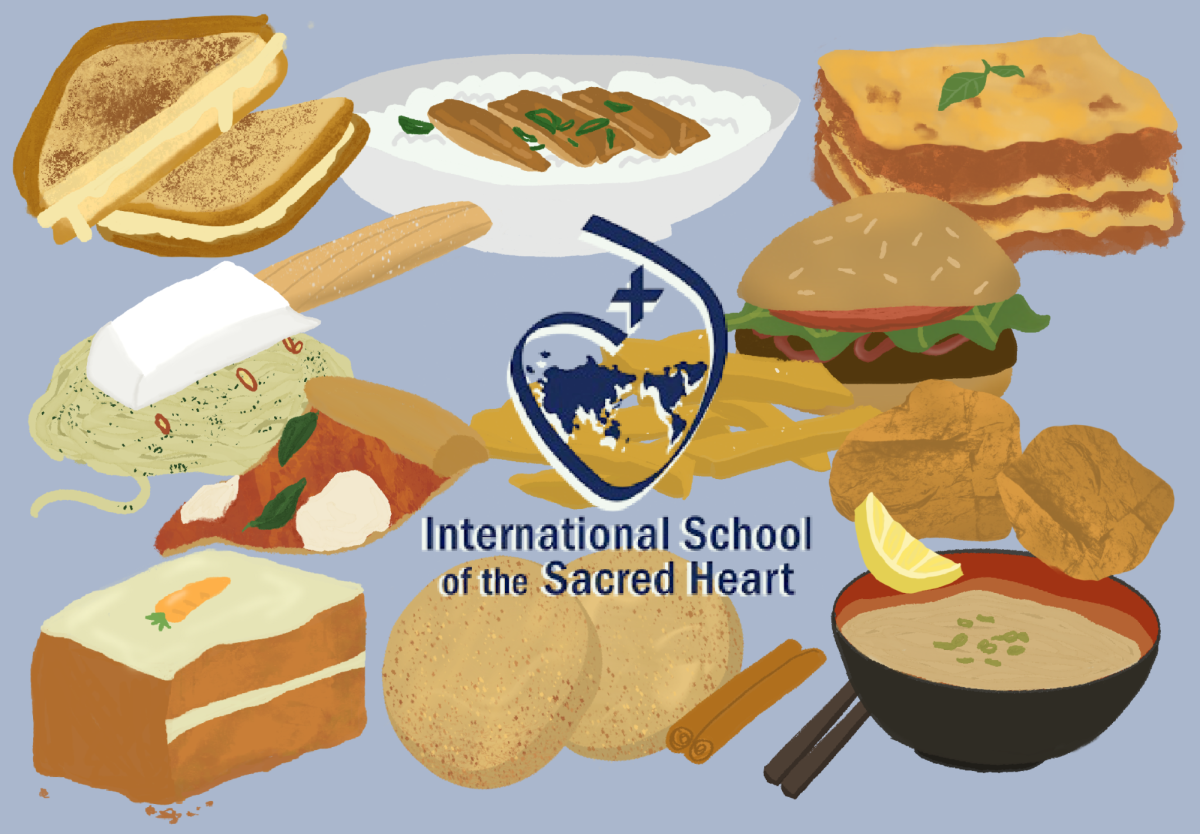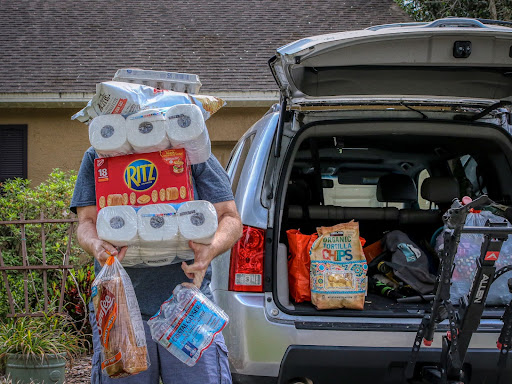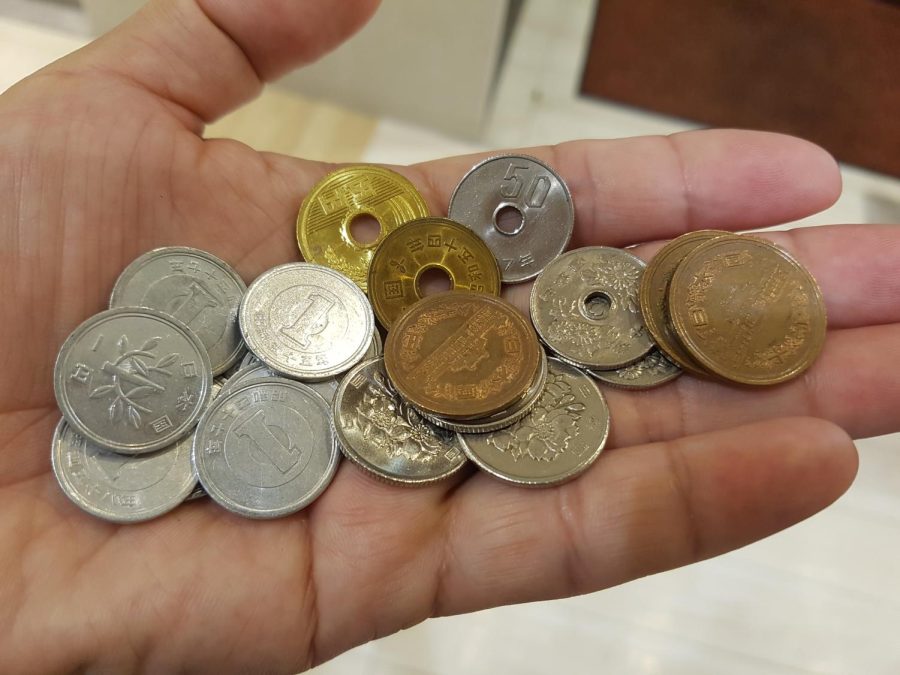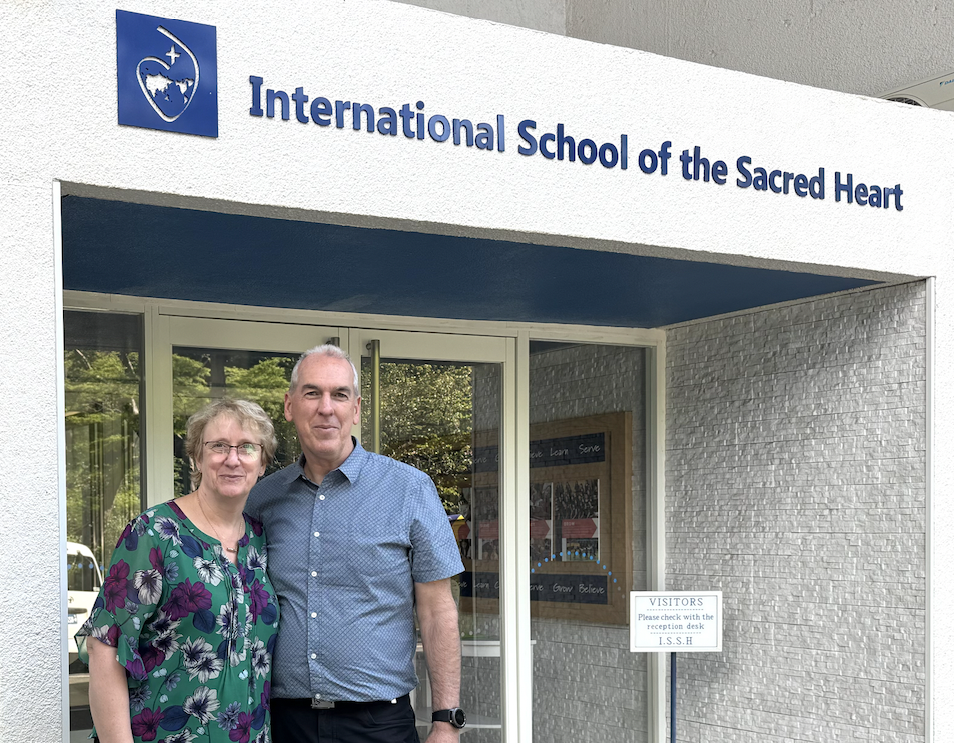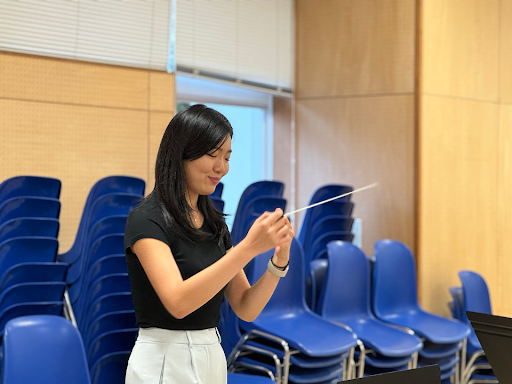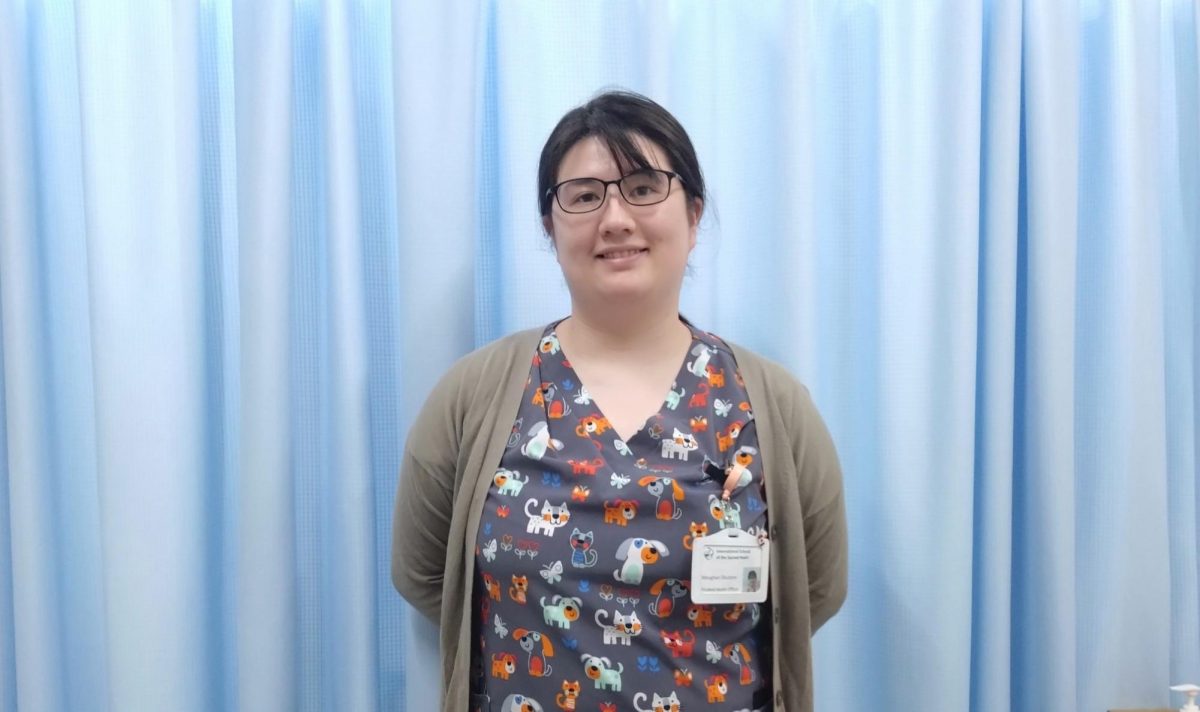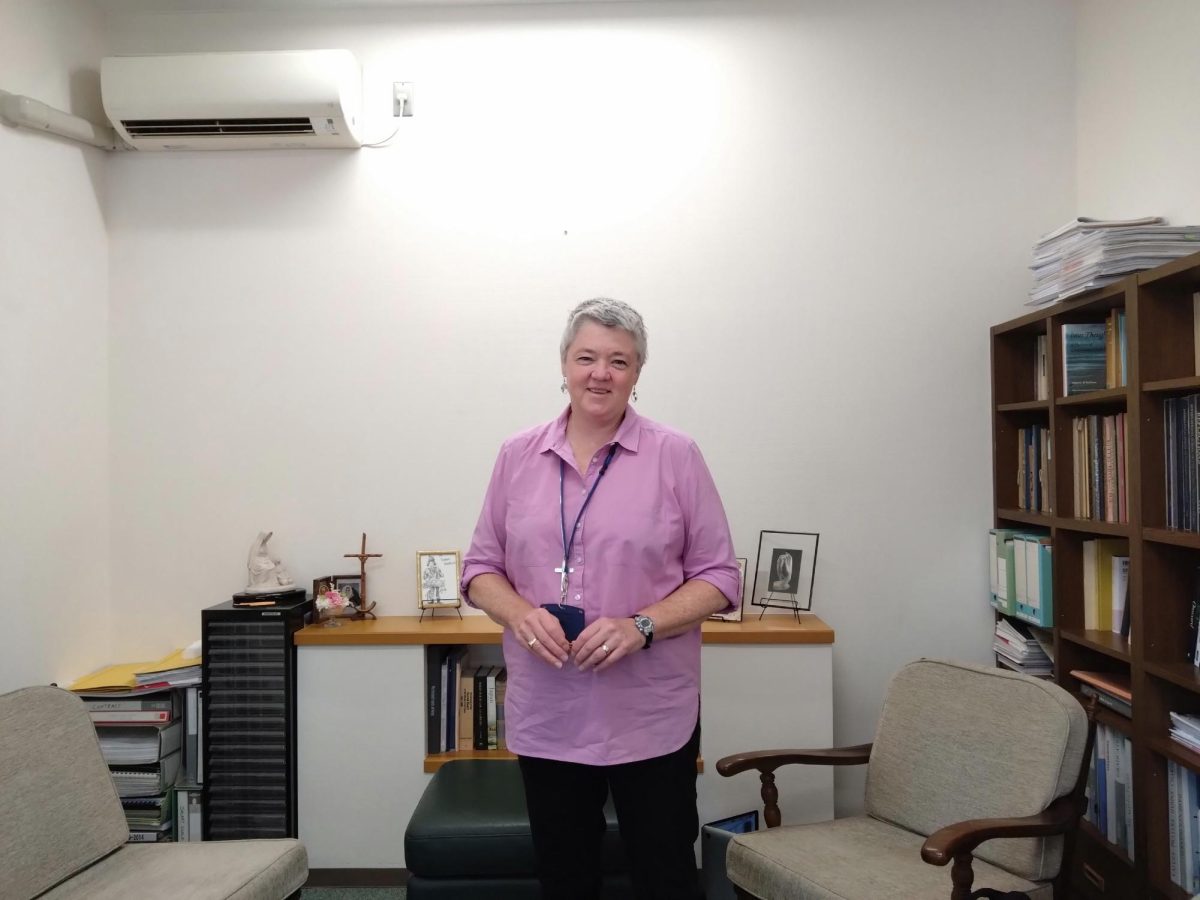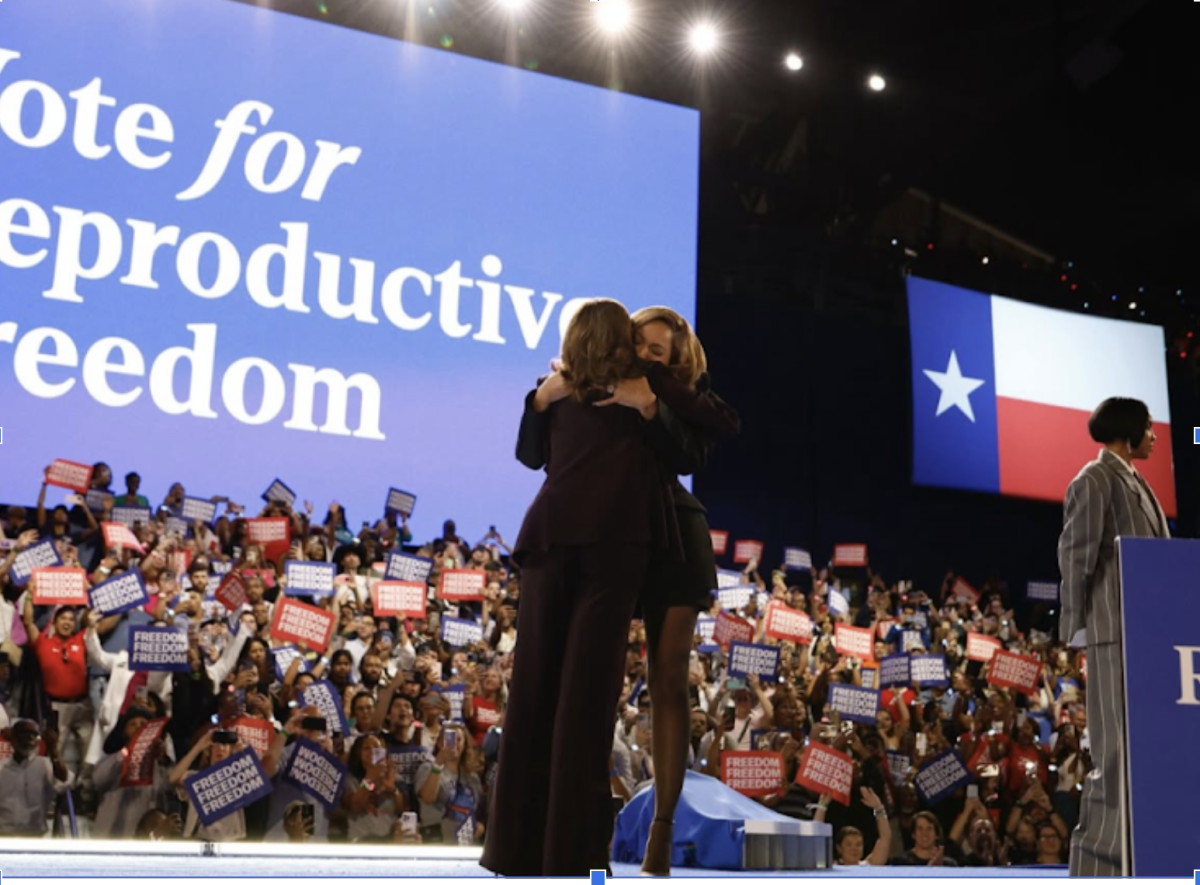In 2003, with hopes of experiencing life beyond Australia, Margaret and James Griffiths, along with their daughter and son, moved to Japan and began working at the International School of the Sacred Heart. At the time, it was meant to be a short stay — just two years abroad to give their children the experience of living overseas.
But what was supposed to be a temporary stay turned into something much more meaningful. Over the next 22 years, the Griffiths would come to consider Sacred Heart not just a workplace, but a home.
The Griffiths’s Early Years at Sacred Heart
Mrs. Griffiths’ first involvement with Sacred Heart was as a part-time substitute teacher. “I still remember the first year that we were here,” she recalled. “I was only teaching part-time, and Mrs. Hayes, the former Headmistress of Sacred Heart, asked me to come and do some substitute work one day to cover some classes. She told me to bring a book to read, and I was used to doing substitute work in Australia, where the children were really badly behaved … I was thinking, there’s no way I’ll have time to read a book.”
To her surprise, the students sat quietly, fully engaged in their studies. “After 10 minutes, I was thinking I should  have brought that book,” she said with a laugh.
have brought that book,” she said with a laugh.
It was the beginning of a realization that would only deepen over time. “I think that students here really value learning,” Mrs. Griffiths reflected. “They appreciate their teachers. They are open to gaining new ideas, and they’re open to trying to understand other people and other cultures. They approach things in a positive way. It’s a very positive environment in which to work.”
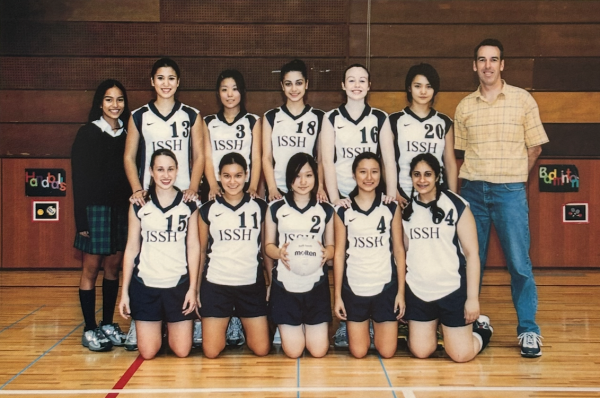
Mr. Griffiths began working at Sacred Heart both as a math teacher and high school volleyball coach. In fact, coaching was such a central part of his role that he joked, “In the first year, I was more employed as a volleyball coach than a math teacher.”
After three years, Mr. Griffiths stepped into the position of a physics teacher. Coming from Australia, where girls’ participation in STEM fields was less common, he had little expectation that students at Sacred Heart would take the Advanced Placement science courses. “It was very rare in Australia to get the girls engaged in STEM projects,” he noted. In addition, just like Mrs. Griffiths, he found himself expecting students to be poorly behaved, given his experience back in Australia, where many of his colleagues were burnt out by discipline issues in local schools. “Back in Australia, there was very little respect coming back from the students,” he recalled.
But here, he was impressed — not only by the number of students taking Advanced Placement science courses, but also by the positive and engaging attitude students have towards learning. Reflecting on his years of teaching, Mr. Griffiths describes the joy of seeing students grasp difficult concepts, especially in hands-on subjects like Physics. It’s challenging to understand the material, “but also more rewarding when you do get that work across.” His time at Sacred Heart always affirmed his initial impressions about the students. “Nearly every day that I come into work, there’s always something that impresses me about the school and about the students and the way they work.”
Sacred Heart becomes a second home
While the students’ enthusiasm for learning left a lasting impression on the Griffiths, it was the deep sense of community at Sacred Heart that ultimately convinced them to stay.
Mrs. Griffiths notes that for many students — especially those who’ve lived in multiple countries — Sacred Heart becomes more than just a school. It becomes a second home. “Maybe for students whose families have always been based in Japan … they are also part of this community and feel a sense of connection here as well.”
Mr. Griffiths echoed his sense of belonging, adding that being part of such an engaged and diverse community has kept him motivated. “I’d probably be more grumpy if I stayed in Australia,” he joked. “When you are here, you’re more engaged because it is a community. I chose to get involved in sports coaching and activities that engage me with the students.”
In addition, Mr. Griffiths notes how former students maintain a strong connection with the Sacred Heart community even after they graduate. “You’ll see alumni come back to this school all the time,” he said. “Some girls will come back nearly every year when they’re back in town just to catch up with people and stay in contact.”
The key to this special connection, according to the Griffiths, lies in the school’s core values. “It’s very much those five goals,” Mrs. Griffiths said. “They really do drive the school.” Unlike many schools where academic results or sports trophies define their community, Sacred Heart prioritizes personal growth. “I feel like I myself have changed and become a better person working at this school.”
Mr. Griffiths agrees. “There’s something amazing about these students that isn’t just knowledge,” he said. “It’s something that’s not tangible to look at … You may not realize it, and you may not appreciate it while you were at school. But, when you get out, you’ll go: Wow, [Sacred Heart] was something actually very different.”
A global community
Another defining feature of Sacred Heart is its remarkable diversity — a trait the Griffiths believe is what creates a welcoming and supportive school community.
Mrs. Griffiths recalls a moment from her first year at Sacred Heart when her daughter expressed her love for the school. “One of the reasons she loved the school was because she was a little bit different and at her school in Australia, she felt different. But here, she said, everyone is different. And so she felt like she belonged, because everyone was coming from different countries, different cultures, and they all had different personalities and they just all got along.”
The Griffiths also emphasize the global awareness fostered at Sacred Heart, something they say stands in stark contrast to their experiences in Australia. “Australia is very insulated, because of the distance from many other countries,” Mrs. Griffiths said. Reflecting on her time in Japan, she points out how much she has learned about global issues. “Schools in Australia wouldn’t have the same push towards social awareness and service as there is here. And I think I have learned so much about various social issues and different things that impact people around the world.”
Not only does the diversity at Sacred Heart deepen one’s understanding of global issues, but it also fosters a peaceful and supportive environment, free from the influence of any political matters. Mr. Griffiths recalls a special moment during Sacred Heart’s annual One World Day. “I still remember that on one particular One World Day act, a Palestinian girl was dancing with one of the Israeli girls. Both of them were ambassador’s daughters.” Given what was happening politically at the time, Mr. Griffiths pointed out, “it’s just incredibly powerful to see that kind of thing … here’s very little of that negativity in this environment. It’s not influenced by the conflicts outside.”
Navigating challenges
Yet, the journey hasn’t always been easy. Over the years, the Griffiths have witnessed Sacred Heart undergo tremendous change—both within the school walls and beyond them. Their time at this school has certainly not been without its challenges.
To Mrs. Griffiths, one of the most striking transformations has been the popularization of social media and its impact on students. Reflecting on her early years at Sacred Heart, she recalled a time when the extent of students’ online presence was limited. “I’m really happy that my children grew up in a time when there was only Facebook and something called MySpace,” she said. “Students weren’t feeling that compulsion to have to be on social media all the time.”
Today, however, even middle schoolers feel the pressure of displaying an online image of themselves. As a long-time middle-school principal, Mrs. Griffiths has witnessed the significant toll that excessive social media use is taking on teenage girls, ranging from perfectionism to heightened feelings of exclusion. “There wasn’t all the pressure of having to be making posts all the time or responding to people’s posts, and living up to different people’s expectations online. You couldn’t see what your friends were doing … whereas now they see all kinds of photos.”
Mr. Griffiths agreed, noting that the expectations and pressures placed on students — whether through social media or even parental influence — are more prevalent than ever. “I think for some girls, it’s not just the perfectionism in social media. I think some of that pressure comes from parents, some of the pressure comes from within the girls themselves — to want to be their best, and to get really good results.” He hopes that students can see that the pressure isn’t always necessary, and success isn’t defined by a single factor. “I wish I had that ability to be able to say that to them,” he said. “It’ll turn out very nicely for you, so don’t stress about it. It all works out.”
But the impact of social media isn’t the only hurdle the Sacred Heart community has faced. During their time at the school, the Griffiths navigated two of the most difficult periods: the 2011 Tohoku earthquake and the COVID-19 pandemic.
Still, Mrs. Griffiths recalled how the community handled the 2011 earthquake very well. “I think the March 11 earthquake was scary for the students, but I think at the same time, the students really appreciated the fact that they were here at school when it happened … Many of them said that if they had been at home, their parents wouldn’t have known what to do. So their teachers took care of them and all of that went well.”
In contrast to the 2011 earthquake, COVID-19 was unlike any other — a pandemic was something that the community had never experienced before, and the virus had posed long-term uncertainty and emotional strain to both the students and the faculty. “The Japanese government gave guidelines to schools, but they weren’t strong directives,” Mrs. Griffiths explained. “Schools had to make decisions themselves as to how they were going to manage COVID in their communities — whether we were going to have only online teaching via video, or whether we were going to have synchronous e-learning.”
The complexity of these decisions made it difficult for the school to determine when and how to reopen. “Many people were scared, understandably, and many people had family members who had been very negatively impacted by COVID … So I think it was very hard for the leadership team; it was very hard trying to follow the science and trying to balance the well-being of everybody as best we could.” While knowing the potential negative effects of prolonged online learning on students’ education, the school could not ignore the risk to the well-being and safety of both staff and students. “I think that was the hardest thing that we had to work through,” Mrs. Griffiths said.
As a Physics teacher, Mr. Griffiths also experienced the difficulty of adapting his lessons to an online environment. “Teaching online was very hard because I want science to be active and hands-on, but you can’t do that from a room at home — It’s hard to keep that engagement there,” he said. Still, he found workarounds by filming experiments and showing videos to the students. “Thankfully, we weren’t online as long as we could have ended up being. So, I think it worked out very nicely for us … and I think the girls have moved on very nicely as well.”
In those moments of uncertainty, the Griffiths faced doubts about whether they could overcome the challenges and continue moving forward. Despite the tough times, the community — both the staff and the students — showed resilience, demonstrating that Sacred Heart could navigate these unexpected hurdles together. In fact, this sense of unity only grew stronger during adversity.
The Griffiths’ parting message to students
When asked what they will miss most about Sacred Heart, neither hesitated.
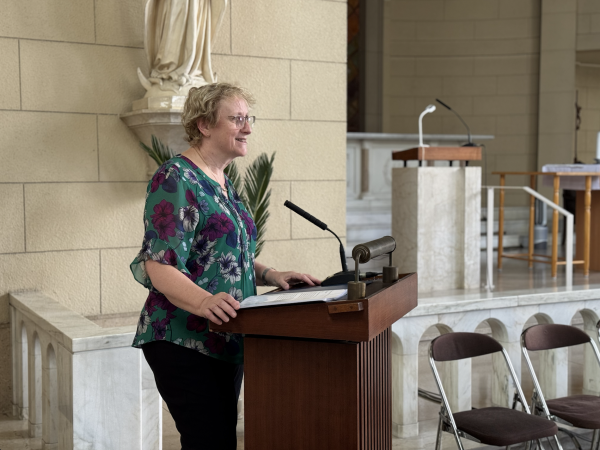
“The students, my colleagues,” Mrs. Griffiths says with a smile. “I never ever wake up in the morning and think, ‘Ugh, I’ve got to go to work today.’ It just doesn’t happen, because the students here make me smile every day — they might disagree with me, but they do. It’s not the buildings or the grounds … It’s the people I’ll miss the most.”
Mr. Griffiths agrees wholeheartedly. “Definitely. One hundred percent the students and teachers. You don’t always get along with every student or every teacher, but here the vast majority do. Probably more so than other places that you work at.”
As they look ahead, their dreams for the school remain clear. “My wish is for Sacred Heart to continue to be a loving, caring, well-respected school,” Mrs. Griffiths said. “I think the relationship between teachers and students is fabulous, and I think the school has a lot of respect in the community. We’re seen as a school that offers really quality education, and an all-round education … I have great confidence that this will continue. I just want the school to be the wonderful community that it has always been.”
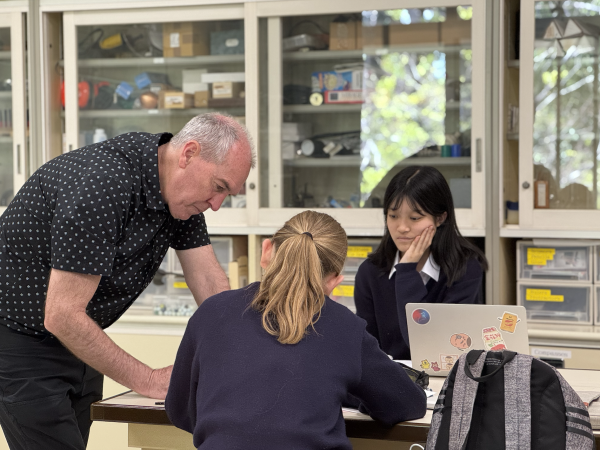
Mr. Griffiths, too, shared his hopes for the future of Sacred Heart. “I want the science program to stay strong. That is my wish,” he said firmly. As a dedicated STEM teacher, he hopes future students will continue to benefit from the wonderful science curriculum here at our school. “I got a huge amount out of learning about science, and I hope that by giving that gift to the students, they will too.”
As a final message to the students, Mrs. Griffiths, reflecting on her years as the middle school principal, wants to remind students to “be accepting of people who are different from you, and be yourself. Don’t feel that you have to change yourself to try and fit in with everybody else,” she said. “Look for the positives in school.”
Mr. Griffiths advises students to be humble and proud in what they do. “You girls have that quality about you in terms of how you have a wonderful skill set and gain wonderful knowledge … To me, that’s a nice quality to have — be proud of it.”
Our connection continues
Although Mr. and Mrs. Griffiths are wrapping up this chapter of their lives, their connection with Sacred Heart is far from being over. “It’s been a huge part of our lives for these past years,” Mrs. Griffiths said. “We will definitely stay in touch with students and faculty and keep showing an interest in what’s happening here at the school.”
Sacred Heart will always be part of their story, just like how they will remain an important part of us and this school. Their daily jokes and warm, approachable presence will be missed, but their dedicated efforts and contributions to both the school and the science department, as well as the values they instilled in the students, will continue to shape Sacred Heart for years to come.


